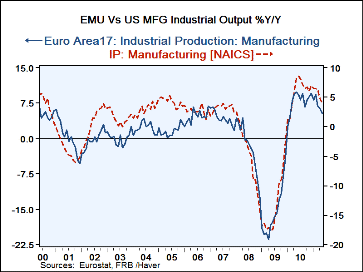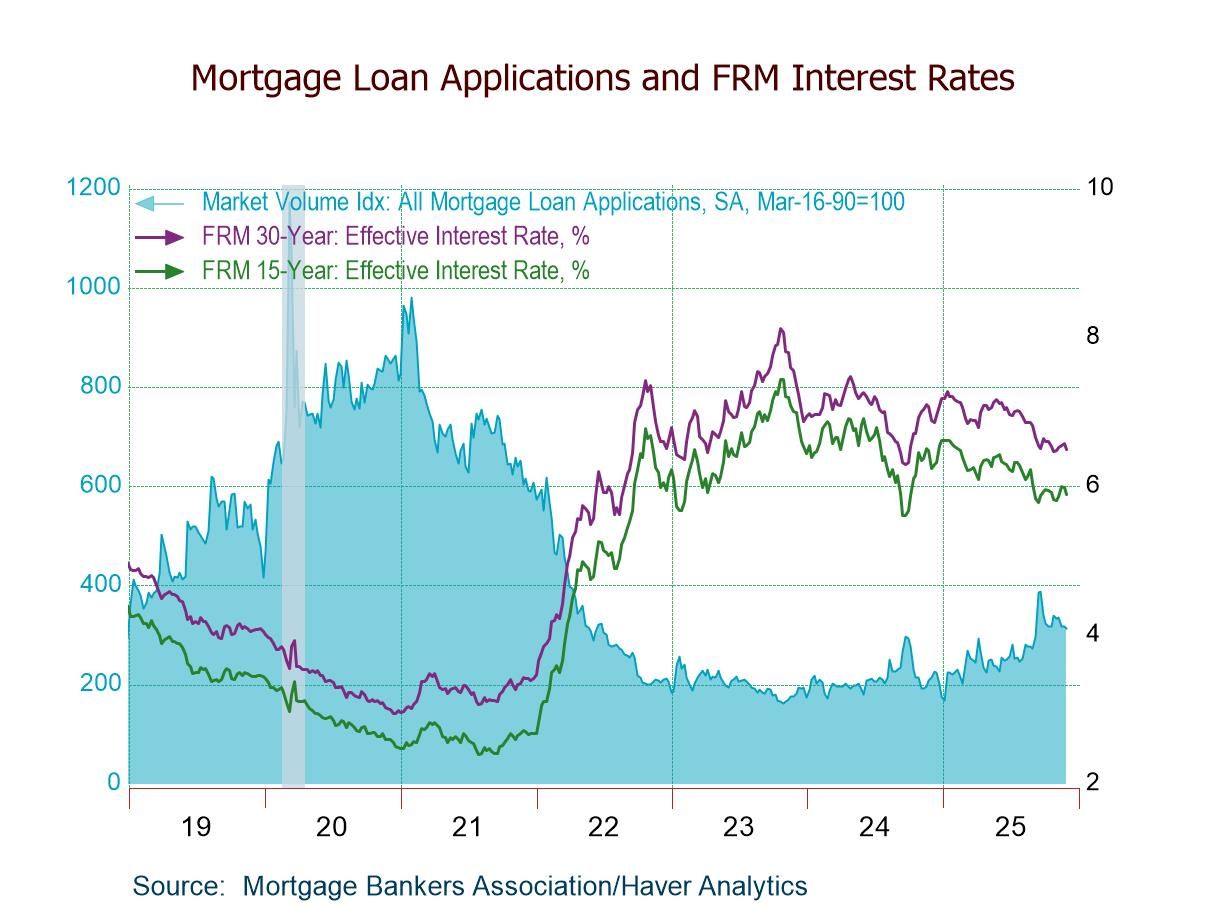 Global| Jul 13 2011
Global| Jul 13 2011Euro-Area and US IP Track One Another
Summary
US and EMU IP in MFG track each other’s respective paths. The world economy clearly is very tightly connected. One up shot of this is that there is not as much gain from diversification as in the past. Of course we are comparing two [...]
 US and EMU IP in MFG track each other’s respective paths. The world economy clearly is very tightly connected.
One up shot of this is that there is not as much gain from diversification as in the past. Of course we are
comparing two real flows of output. Inflation in the US does differ from inflation in the Zone and the more
important difference is that the US dollar/euro exchange rate continues to be volatile despite relatively
closely correlated MFG output.
US and EMU IP in MFG track each other’s respective paths. The world economy clearly is very tightly connected.
One up shot of this is that there is not as much gain from diversification as in the past. Of course we are
comparing two real flows of output. Inflation in the US does differ from inflation in the Zone and the more
important difference is that the US dollar/euro exchange rate continues to be volatile despite relatively
closely correlated MFG output.
While there is a lot of concern about the MFG slowdown in the US and in Europe it appears that the two episodes have a lot in common although much of the discussion seems to cite separate factors for each slowdown. Maybe the common factors are the more important ones?
It is possible that the US and EMU have a lot of factors in common but that each also has a few separate factors operating at the same time. In Europe, the uncertainty on the debt front is a key issue there. It may have some impact on the US but it is not as big an effect on the US economy. But the US has its own debt situation that is exaggerating uncertainty, too. While these two debt issues are ‘separate’ they are certainly linked at least in the sense that the US is seeing in Europe’s experience the sorts of things that can happen if debt is allowed to compound unimpeded. Japan’s devastating shocks hit both the US and Europe, further connecting the two MFG sector’s oscillations. High oil prices hit the US and Europe together but hit the US harder than Europe since its energy costs are lower and the hike in the market prices hits US consumers harder as a larger percentage hike. On balance there are a mix of similar and yet different factors that are buffeting the US and Europe.
The more we drill down into this issue, the more we see that there are a lot of commonalities in the US and European economies. Though, separated by a great ocean these modern economies are still quite interdependent.
| Euro-Area MFG IP | ||||||||||
|---|---|---|---|---|---|---|---|---|---|---|
| SAAR Except M/M | Mo/Mo | May 11 |
Apr 11 |
May 11 |
Apr 11 |
May 11 |
Apr 11 |
|||
| Euro-Area Detail | May 11 |
Apr 11 |
Mar 11 |
3Mo | 3Mo | 6Mo | 6Mo | 12Mo | 12Mo | Q:2 Date |
| MFG | 0.0% | 0.1% | -0.3% | -0.7% | 4.2% | 5.0% | 8.2% | 5.3% | 6.4% | -0.3% |
| Consumer | -0.2% | 0.7% | 0.3% | 3.5% | 7.1% | 3.3% | 4.8% | 2.2% | 3.3% | 2.4% |
| C-Durables | -0.5% | 1.0% | 0.1% | 2.1% | 7.2% | 5.5% | 5.2% | 0.9% | 4.5% | |
| C-Non-durables | -0.4% | 0.4% | 0.7% | 2.6% | 8.4% | 2.4% | 4.8% | 2.0% | 3.7% | |
| Interm. | -0.1% | -0.1% | 0.1% | -0.4% | 2.3% | 3.6% | 7.9% | 4.3% | 5.4% | -0.9% |
| Capital | 0.6% | 0.6% | -0.6% | 2.4% | 9.2% | 7.1% | 6.8% | 9.4% | 10.4% | 4.9% |
| Main Euro-Area Countries and UK IP in MFG | ||||||||||
| Mo/Mo | May 11 |
Apr 11 |
May 11 |
Apr 11 |
May 11 |
Apr 11 |
||||
| MFG Only | May 11 |
Apr 11 |
Mar 11 |
3Mo | 3Mo | 6Mo | 6Mo | 12Mo | 12Mo | Q:2 Date |
| Germany | 1.3% | -0.3% | 1.1% | 8.8% | 10.9% | 11.2% | 7.1% | 8.9% | 11.1% | 8.5% |
| France:IPx Const |
2.0% | -0.5% | -0.8% | 2.6% | -3.3% | 5.2% | 6.0% | 2.6% | 2.6% | 0.4% |
| Italy | -0.7% | 1.0% | 0.6% | 3.6% | 12.8% | 2.0% | 6.0% | 1.8% | 4.1% | 7.6% |
| Spain | 2.3% | -3.4% | 0.1% | -4.2% | -16.6% | 0.7% | -1.7% | -0.8% | -2.0% | -11.9% |
| Ireland | 0.5% | 1.2% | -1.4% | 1.1% | -8.0% | 1.7% | 2.0% | 0.1% | 4.4% | -0.7% |
| Greece | 2.0% | -5.6% | -1.6% | -19.6% | -29.2% | -12.7% | -18.1% | -10.3% | -10.9% | -26.1% |
| Portugal | 2.8% | -3.5% | 0.8% | -0.4% | -2.2% | 6.1% | 2.2% | -0.3% | -1.6% | -4.5% |
| UK: EU member | 1.9% | -1.6% | 0.1% | 1.3% | -6.3% | 1.5% | -1.3% | 2.9% | 1.2% | -3.2% |
| Some Euro-Area reporters are timely
and some lag. This table allows a sequential inspection of trends regardless of topicality |
||||||||||
Robert Brusca
AuthorMore in Author Profile »Robert A. Brusca is Chief Economist of Fact and Opinion Economics, a consulting firm he founded in Manhattan. He has been an economist on Wall Street for over 25 years. He has visited central banking and large institutional clients in over 30 countries in his career as an economist. Mr. Brusca was a Divisional Research Chief at the Federal Reserve Bank of NY (Chief of the International Financial markets Division), a Fed Watcher at Irving Trust and Chief Economist at Nikko Securities International. He is widely quoted and appears in various media. Mr. Brusca holds an MA and Ph.D. in economics from Michigan State University and a BA in Economics from the University of Michigan. His research pursues his strong interests in non aligned policy economics as well as international economics. FAO Economics’ research targets investors to assist them in making better investment decisions in stocks, bonds and in a variety of international assets. The company does not manage money and has no conflicts in giving economic advice.






